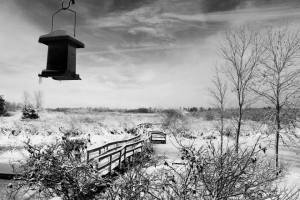
The State of the Woods
It’s zero degrees as we walk into the forest, but sunny and no wind. The air smells and feels clean, as if it’s been sanitized by the cold. Dry light snow clings to the dead goldenrod heads, cedars, and crotches of the branched alder shrubs. When we stop, we can hear chickadees and nuthatches in the forest even though there isn’t a bird feeder nearby. The world is hushed and peaceful yet brisk and energizing at the same time. How lucky we are to live here.
After a half hour, nose and toes suggest that perhaps the warm indoors might help maintain a good comfort balance, and the wind is expected to come up besides. A good time to head back and face the workday.
The deep midwinter. Slumber, death, and cold all around. Mostly slumber, really, as every living thing has a way to carry on by surviving or passing on it’s genes to next summer’s life. Beneath our feet, the snow, and the grass or leaf cover, are hundreds of thousands of species of all sorts- microscopic things, fungi, plants, and animals that are woven together in perhaps the most complex ecosystems of all, but unseen by us. In natural areas, the frost doesn’t usually extend very deep, and many living things continue to thrive although at perhaps a bit slower rate than when warm. Typically, the soil at about six feet deep remains the same temperature year long- reflecting the annual average temperature of the world above. Most of the life in the soil, however, is in the upper three feet. As we study the soil, we are gradually learning about ways that the life there interacts, how extensive in size are some soil organisms, and even how plants sense conditions and pass information to others through their roots.
Large animals also depend on the stability of the soil ecosystems in winter. Rodents like woodchucks and ground squirrels sleep deeply and are protected underground. Some tree squirrels like chipmunks also sleep but less deeply, waking for short periods every several weeks for a meal and bathroom break. Badgers take to their burrows for long periods, and canines like foxes and coyotes may use dens if needed, although they are more important in a month or so when this year’s pups need a home. Bats are amazingly good at finding cracks in surface bedrock that lead to underground chambers suitable for their sleep. The red bat, however, might bury itself in the leaf litter on the forest floor or find a hollow tree, waking up and searching for early insects on the fly when temperatures reach the 50’s. When it gets cold again, they go back to sleep until Spring makes up it’s mind to stay.
Amphibians don’t often dig deep it seems. Green and leopard frogs dive to the pond bottoms and breathe through their skin to make it through winter. Others, like gray tree and wood frogs, toads, and salamanders hide beneath the leaves or excavate a bit to keep covered, and tough it out. That some of these can actually freeze, protecting their cells at the last minute from bursting with a shot of natural anti-freeze, seems miraculous. And that seemingly simple but elegant creatures like insects and spiders can sometimes remain active on or below the snow, or produce eggs or larvae which can withstand winter even if their parents perish, is wonderful to observe. Their persistence to continue the lives of their kind is remarkable.
The animals we see are persistent as well- the winter birds, rabbit’s, deer, and the like. It’s not been too bad a winter for them so far. Cold but not too much so, and not much snow to hide the branches and seeds on which they feed. They’ve either adapted to eating abundant but not too nutritious food like twigs, or have developed brains which help them find and remember food sources. It turns out that birds are more intelligent than we used to think, and they need that to keep finding enough energy so that they can fuel the continuous shivering that keeps them warm.
In a few weeks the hardiest of animals will have made it through winter or through their migrations, and they will begin repopulating the world around. Enjoy the quiet of the deep midwinter, because things will become busy soon.
